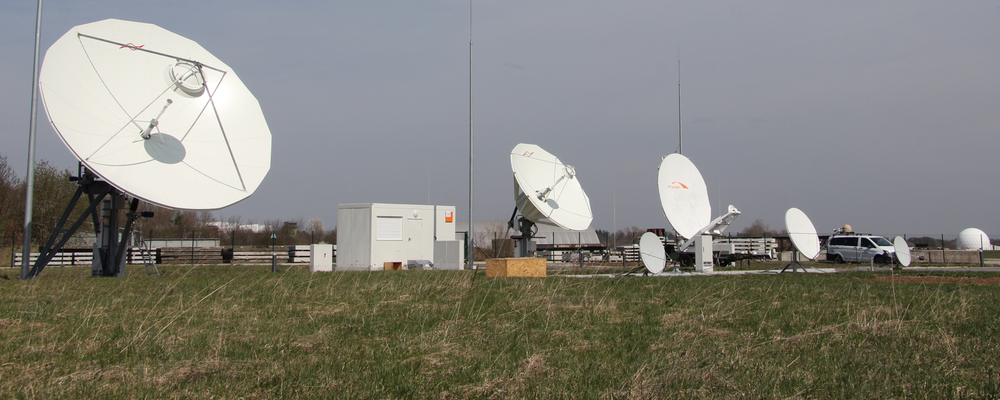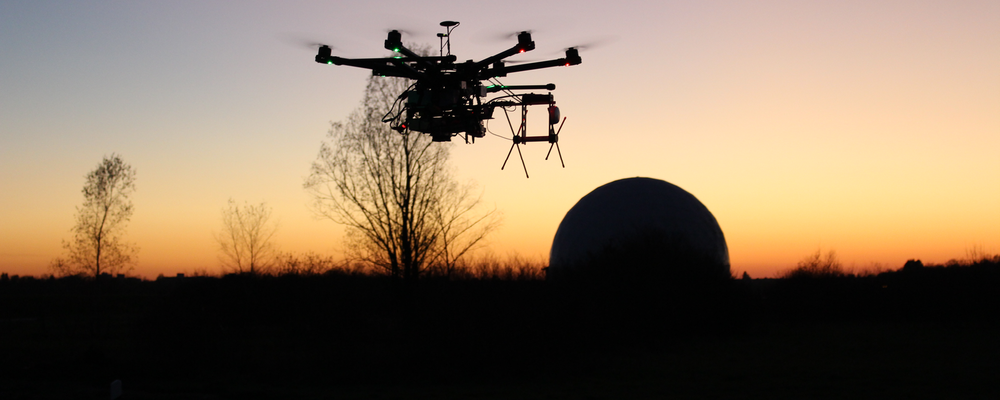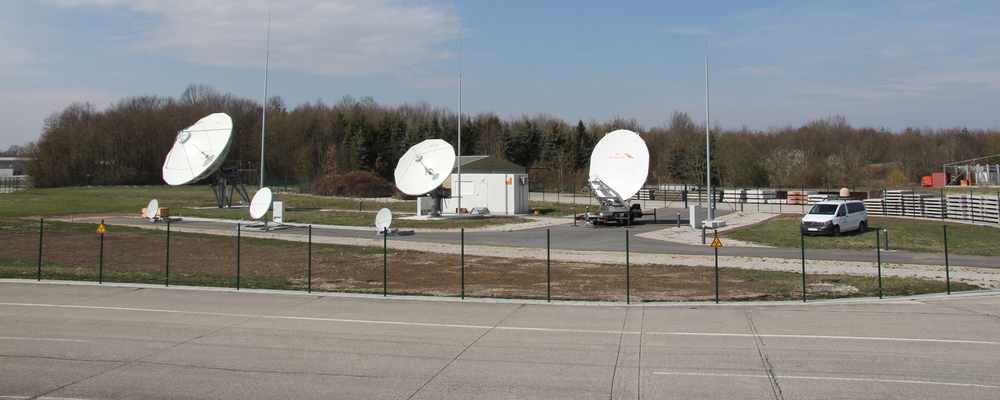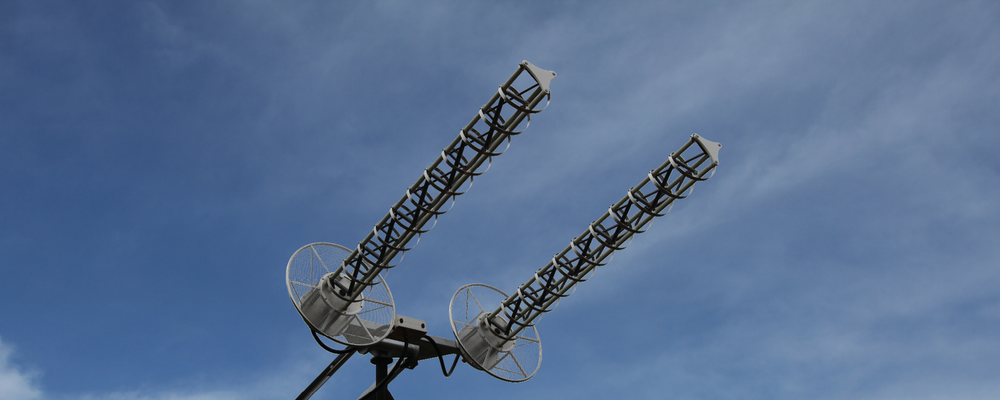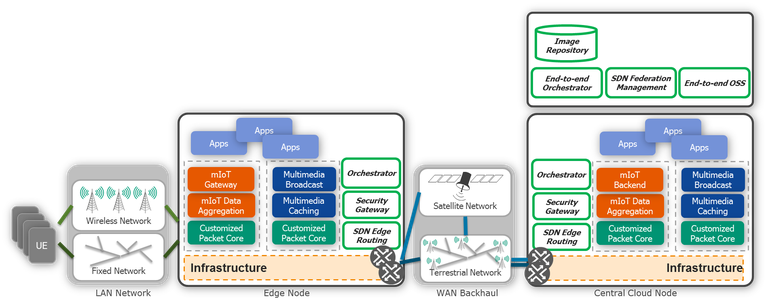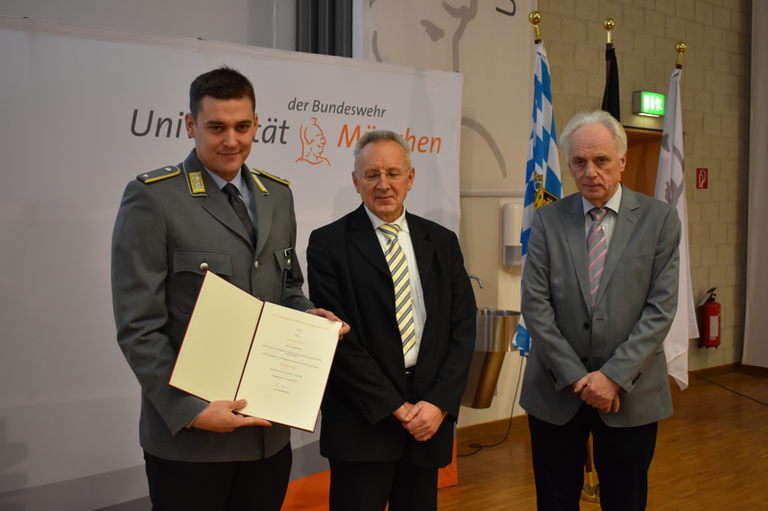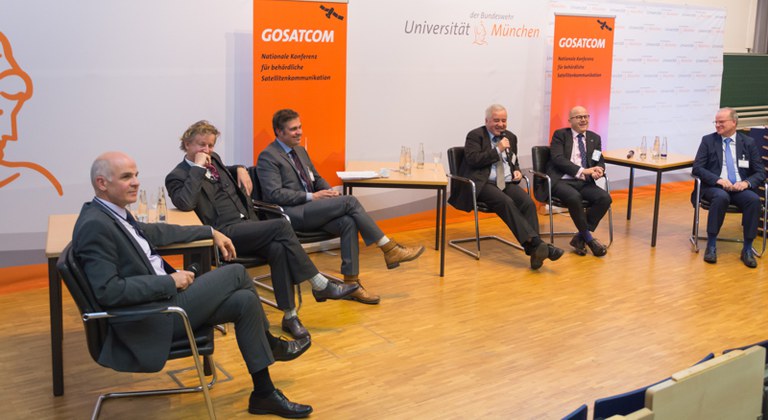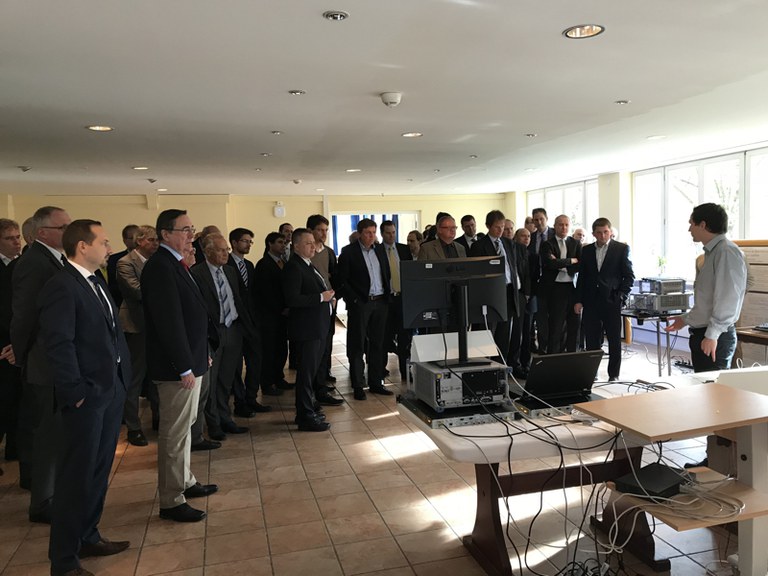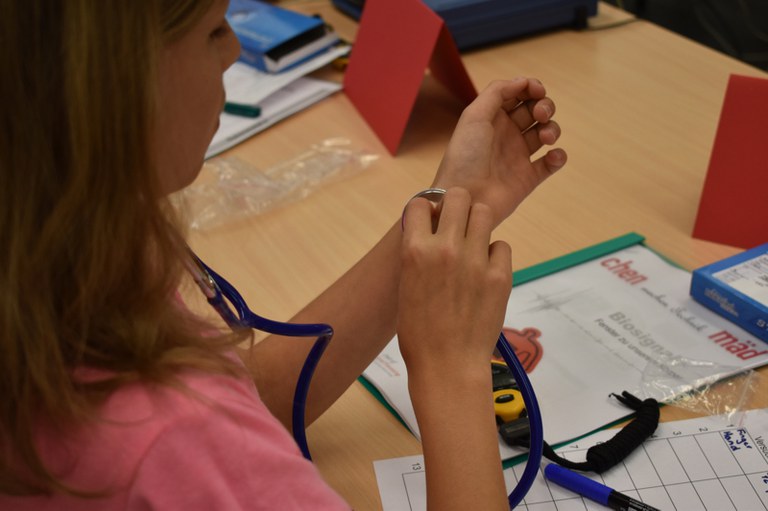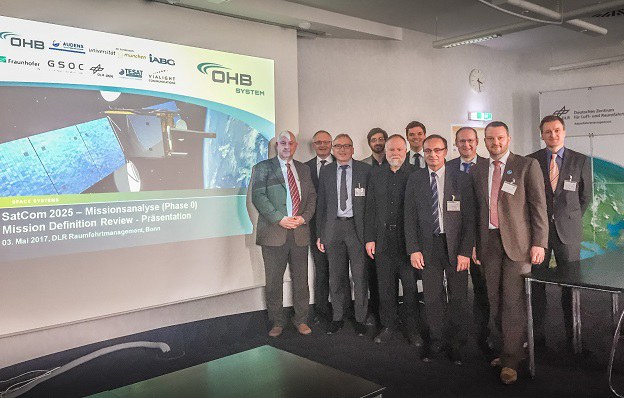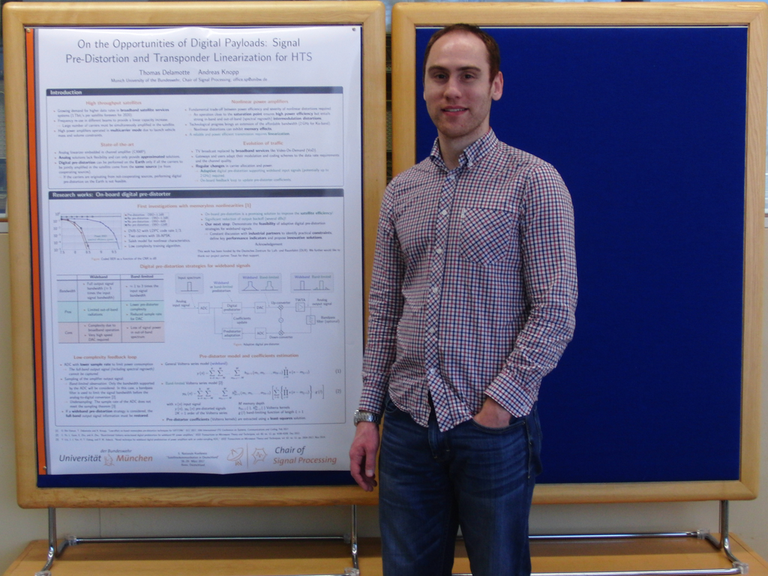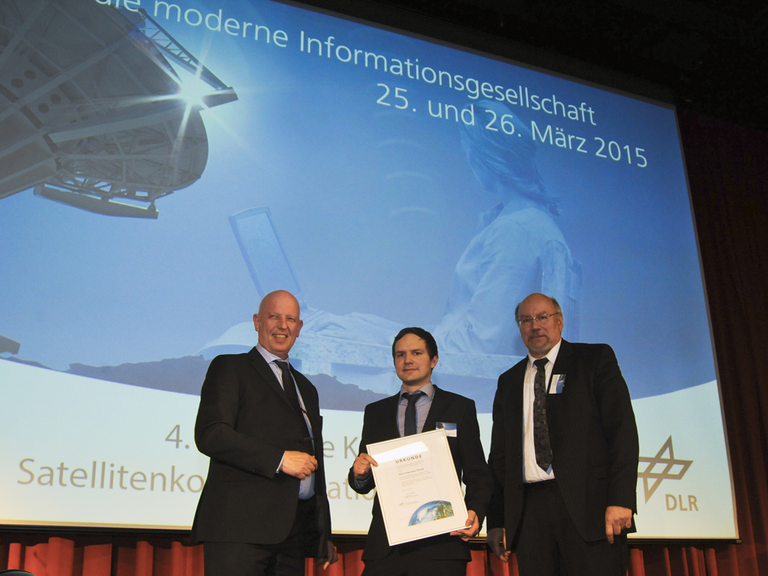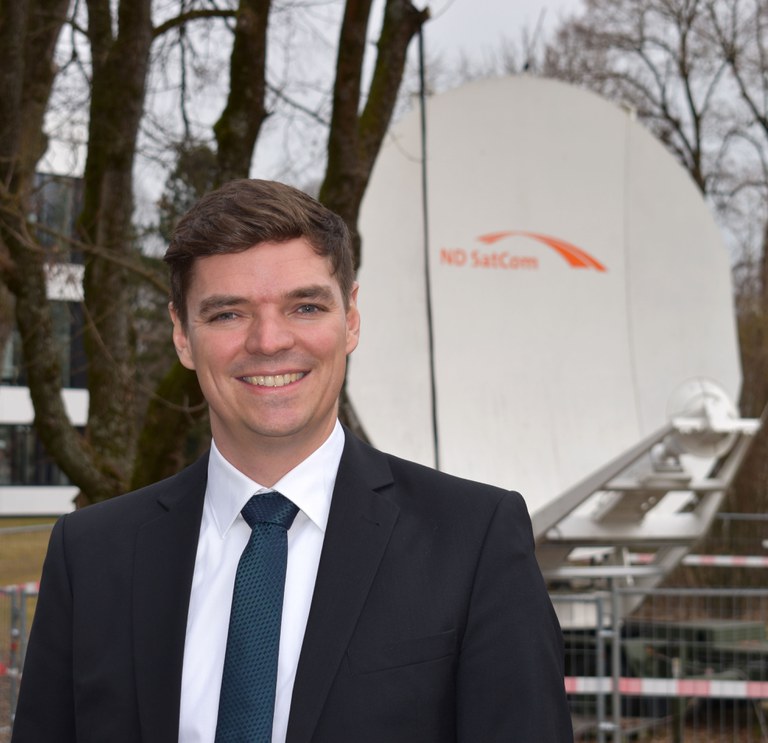| newer News / older News |
Award for PhD student Matthias G. Schraml December 23, 2017 The Institute for Information Technology awarded the “Best Publication 2017 Award” to Matthias Schraml who authored the publication entitled “Blind Estimation of the HPA Operating Point in Multicarrier Satellite Transponders”. The paper, which appeared in the renowned journal ‘’IEEE Communications Letters’’, proposes a novel method for the estimation of the operating point in satellite transponders when the input signal is of multi-carrier type and unknown to the measurement device. Operating point estimation has always been a problem if high practical relevance because satellite operators want to drive their transponders close to saturation for maximum power efficiency while preserving a distinct back-off to limit the intermodulation noise. The novel method opens up a strategy to measure the operating point without any a-priori knowledge about the signal and from any position within the satellite beam. Congratulations to Matthias!
|
5G Satellite Demonstration Testbed Initiative with ESA December 14, 2017 Satellite communications could play a major role in the 5th generation of future telecommunication network standards (5G). The Chair of Signal Processing is contributing to the ESA’s ARTES project, SATis5, a demonstration of satellite-terrestrial integration for 5G networks.
The SATis5 project will present live demonstrations of 5G satellite use cases such as enhanced mobile broadband (eMBB) and massive machine type communications (mMTC) scenarios using the SATis5 testbed. The SATis5 testbed will be developed in 2018 and includes nodes with prototypes of networks for satellite integration, along with other 5G nodes located in Berlin, Erlangen and Betzdorf, and an additional portable node. The demonstrations will display satellite integration capabilities in a mix of infrastructures for 5G and foster adoption of satellite as part of the 5G architecture. From the perspective of the satellite connectivity, two modes are considered: backhaul connectivity for terrestrial 5G networks and direct 5G communication. “The ESA SATis5 project is a great opportunity to contribute to the future satellite-terrestrial network integration. Such hybrid networks using satellite communication will be the future of telecommunications,” said Professor Knopp. The SATis5 project team is led by Eurescom and further comprises SES, Fraunhofer FOKUS, Fraunhofer IIS, Newtec, Technische Universität Berlin and the Chair of Signal Processing. |
Gereon Such honored for his Master Thesis December 9, 2017 Master student Gereon Such receives the 2017 “Best Master Thesis Award” issued by the Neubiberg based research funding society “ITIS e.V.”. The award has been presented to Gereon by Prof. Dr. Christian Thienel, the University’s Vice President for research matters. In his laudatory speech Prof. Thienel pointed out that Gereon’s thesis entitled “Performance gain Analysis of a Volterra Series Equalizer for Tactical Satellite Communications” impressively shows how a complex mathematical theory can be systematically tailored and applied to practical systems without loss of exactness and generality. “It is especially this kind of competence that sets apart a great engineer” the Vice President added. Congratulations to Gereon!
|
GOSATCOM 2017 – A Successful Follow-Up From 13th to 15th November the Chair of Signal Processing in collaboration with ITIS e.V. hosted the second National Conference on Governmental Satellite Communications (GOSATCOM 2017). About 180 participants from industry, Bundeswehr, governmental institutions and academia met in Neubiberg to attend the presentations and discuss the future of governmental satellite communication (GOVSATCOM) in Germany and within Europe. Keynote speaker Brigadier General Jens-Olaf Koltermann, Head of IT-Department at BAAINBw, pointed out that satellite communication is an essential part of our national crucial communication infrastructure. The keynote presentation of Prof. Dr. Frank Schäfer, deputy head of the Freiburg based Fraunhofer Institute for High-Speed Dynamics, Ernst-Mach-Institute, demonstrated impressively the potential of novel microsatellites for GOVSATCOM.
The biennially held GOSATCOM has been created by the SATCOM team of our institute, having its premiere in October 2015. The participants of the second conference in 2017 very much appreciated the discussion and information exchange between the governmental, industrial and scientific communities. Many thanks to all speakers, contributors, and participants for making the conference a great success again. We would like to express our sincere gratitude also to our industrial partners, exhibitors, and the entire organization team. Great job! More information about GOSATCOM 2017 (in German) is provided here. See also our web page: www.gosatcom.de |
|
AG Telekom @ UniBw November 13, 2017: The second 2017 Telecommunications Experts Group (AG Telekom) meeting of the Space Administration Division (Raumfahrtmanagement) in the German Aerospace Center (DLR) has been hosted by the Chair of Signal Processing at UniBw M. According to the lead topic “5G over Satellite”, 50 experts from industry and research institutes discussed the role of satellite communications as well as the DLR’s strategic agenda for the funding and the development of Germany’s technological capabilities in a growing market of next-generation mobile telecommunications. The DLR Space Administration Division is the leading funding organization of scientific and early-bird space technology in Germany. The funds are provided by the German Ministry of Economic Affairs (BMWi) and are allocated in a highly competitive procedure. In this respect, it has been a great opportunity for the UniBw to show its scientific capabilities and major research achievements in the field of cutting-edge satellite communications technologies. Especially the satellite based multi-antenna transmission technology (MIMO), which has been developed and brought to maturity over the last decade by our institute, gained huge interest among satellite service providers. This technology has been funded in two major programs by the DLR. Moreover, the institute’s research activities in the field of highly resilient Internet-of-Things (IoT) transmission methods were in the spotlight.
|
|
Ten years of “BIOSIGNALS - windows to our body” August 1-3, 2017: Launched August 2008, the project “BIOSIGNALS – windows to our body” is an integral part of the annual “Girls and Technology” summer school of the Bavarian universities and research institutions dedicated to inspire girls aged between 10 and 16 years to explore the possibilities of technology, engineering and math professions.
In the last decade more than 90 teenage girls have participated in the BIOSIGNALS project. During the three project days the girls proactively experienced a variety of biomedical signal registration and analysis techniques which are used by physicians for clinical diagnosis and employed by scientists for basic research. From the simple mechanical stethoscope up to the fundamental principles of computer tomography and magnetic resonance imaging - after a short introduction to the theoretical and technical background the girls conducted experiments and measurements by themselves, thus getting a tantalizing glimpse into the fascinating field of biomedical information technology. Assisted by students and staff members the young scientists enthusiastically mounted electrodes and registered cardiac, muscular and cerebral activity. They analyzed heart rates and reaction times and they explored the power and limitations of the human brain. Even in its tenth year, we were highly impressed by the curiosity, the clever questions, and by the amazing scientific creativity of the girls participating in the project. BIOSIGNALS project team 2017 Lt zS Claudia Hacker (student tutor BIOPAC) Josef Dochtermann (logistics, IT systems) Wolfgang Hanzl (logistics) Wolfgang Weber (experimental setup, bioelectricity) Prof. Dr.-Ing. Werner Wolf (driving simulator) PD. Dr.-Ing. Gerhard Staude (direction and presentation) |
|
Quo Vadis Satellite Communication? May 4, 2017: The question about the future of satellite communication is reasonable to ask in times when the classical application for satellite communication, the TV broadcast, is changing by video-on-demand offers that could be accessed everywhere at any time via internet. Additionally, new applications like the internet of things are arising and further increase the demand for high data rates in communication networks.
The study “Satcom 2025” on the future of satellite communication tries to answer that question and develops a proposal for a new German national satellite mission. The project has been granted by the National Aeronautics and Space Research Centre (DLR), Space Administration and is carried out by different project partners from industry and academia. Our contribution in a major role within the consortium is carried out by Assistant Prof. Hofmann. The study delivered a proposal for a geostationary satellite mission that could provide high data rate internet access as well as ultra-high density (UHD) television to end users in Germany via satellite. Thus, in our opinion, the roadmap towards competitive future satellite communication is based on increasing the throughput to serve more users with higher data rates. The MIMO technology, which is the most promising technology for that attempt, has been an important part of our research in the last years and is now an essential part of the proposal for the Satcom 2025 mission. |
|
Digital payload algorithms among the trendsetting technologies for space March 30, 2017: Thomas Delamotte achieved a great second place out of 20 final competitors during this year’s 5th biennial “German National Conference on Satellite Communications” in Bonn’s Grand Hotel Kameha. Almost 350 participants from industry, government, and academia were invited to give their vote for the most relevant and trendsetting technology for the future of satellite communications. The competitors had to present their topics and ideas in a 3 minutes pitch in front of the audience, followed by the two days conference where the voters were able to ask questions and discuss. In this context, digital satellite payloads and signal processing algorithms were rated of major relevance in future multi-carrier communications like for the support of IoT or M2M applications. Since this conference is the most relevant forum in the German satellite and space communications industry, many upper-level managers and R&D directors were among the audience, providing desirable feedback for researchers on the practical relevance and impact of their work.
|
5. Nationale Konferenz Satellitenkommunikation in Deutschland March 28-29, 2017: The 5th biennial “German National Conference on Satellite Communications” in Bonn’s Grand Hotel Kameha is approaching. This event is the premier conference of the German Air and Space Management Authority DLR, bringing together renowned experts from national air and space industry, academia and government. This year’s conference will be dedicated to new trends in utilization of SATCOM for Industry 4.0 and Internet of Things. Having been the winner of the 2015 “Next Generation SATCOM Award” issued by this conference, and ranging among Germany’s top level satellite and space research institutions, we are keen to contribute several talks and poster presentations to this year’s event. Our topics will cover a wide range of SATCOM applications, in particular:
|
|
The Bundeswehr’s SATCOM Test Center March 1, 2017: The Chair of Signal Processing has been selected to establish a Verification and Test Range for the radio equipment procurement program “MoTaKo”. The multi-year MoTaKo program is considered as the biggest procurement program for mobile and wireless communication equipment ever launched by the Bundeswehr. MoTaKo will renew and modernize thousands of military radios covering the entire frequency band used today for military communications, starting from HF and ranging to EHF satellite communications. In this context the Bundeswehr has decided to establish a test and verification facility for equipment and interoperability tests, and our institute has been awarded a long-term contract and budget for the design, development and assembly of the SATCOM related facility part. This test facility called “VeriTAS” (Verification and Test Assembly for SATCOM) will be integrated into our unique SATCOM Center for Experimentation Research and Test (SatCERTBw), forming Germany’s most powerful military over-the-air (OTA) SATCOM test range.
|
|
Dr. Christian Hofmann is now Assistant Professor February 3, 2017: On 1st of February Dr. Christian Hofmann has been appointed the OHB endowed Assistant Professorship for “Secure Space Communications” at the Chair of Signal Processing. This industry sponsored professorship is dedicated to research on physical layer security of space applications. Located in the vicinity to the Bundeswehr’s Research Center for Cyber-Security, the professorship will contributed with research on how to design radio signals for space in a way which makes jamming, spoofing or eavesdropping tricky or even impossible.
More information can be found here. (in German only) |
| newer News / older News |
News 2017

